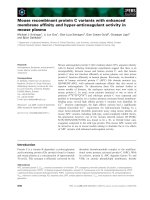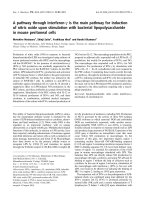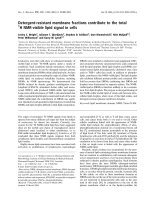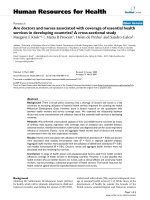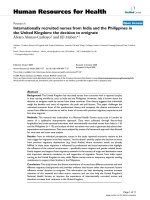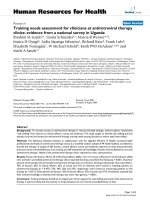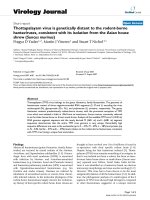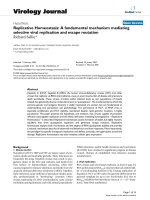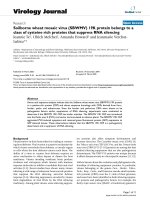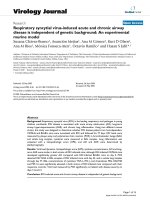Báo cáo sinh học: " Will he still look good with the lights on? Spectral tuning of visual pigments in fish" docx
Bạn đang xem bản rút gọn của tài liệu. Xem và tải ngay bản đầy đủ của tài liệu tại đây (599.82 KB, 4 trang )
Minireview
WWiillll hhee ssttiillll llooookk ggoooodd wwiitthh tthhee lliigghhttss oonn?? SSppeeccttrraall ttuunniinngg ooff vviissuuaall
ppiiggmmeennttss iinn ffiisshh
Julia C Jones, Helen M Gunter and Axel Meyer
Address: Lehrstuhl für Zoologie und Evolutionsbiologie, Department of Biology, University of Konstanz, D-78476 Konstanz, Germany.
Correspondence: Axel Meyer. Email:
Early work on animal behavior by Jakob Uexküll defined
each animal’s perceived world as its Umwelt. In this regard
every species lives in its own world. Bats ‘hear’ their world
mostly by echolocation, elephants communicate with very
low-frequency sounds and, likewise, the ultraviolet (UV)
world of insects is hard for us to imagine. We live in a world
that we perceive to a large extent through vision, as do
many other organisms. But not all visual worlds are the
same; each species perceives only a subset of light wave-
lengths, which are determined by various evolutionary
pressures. For example, color-driven sexual selection is rife
among fish, including sticklebacks, cichlids, and poeciliids
(guppies and swordtails) [1-3] - the family that cichlids
belong to is aptly named Buntbarsche in German, which
translates as ‘colorful perches’. Cichlids and guppies display
stunning color diversity, whereby males differ markedly in
coloration from females [4,5], but they pay a price for this
by increasing their risk of predation. Furthermore, the
vision of each species is tuned to its spectral environment
and must enable a balance between successful foraging,
predator avoidance and the choice of attractive mates. Also,
during development, the requirements of the fishes’ visual
worlds might change because larvae and adults feed on
different foods, live in different places or are preyed on by
different predators. Therefore, it is important to understand
how sensory cells might change not only during their
evolution, but also during their development. Specifically,
what are the developmental and genetic mechanisms that
shape the unique visual palettes of different species?
The vertebrate retina is a complex structure that can detect
wavelengths that span from UV at about 350 nm to far red
at about 630 nm [6]. This range is determined primarily by
the ratio of rods to cones and the visual pigments that they
contain [7]. The opsin pigment genes are a central factor in
determining the visual landscape that species can detect.
Vertebrate visual pigments are classified into six evolution-
arily distinct classes on the basis of the parts of the visual
spectrum they are most sensitive to. These classes are RH1
(rhodopsin; about 500 nm absorbance), RH2 (rhodopsin-
like; 470-510 nm), SWS1 (short wavelength; 360-430 nm),
SWS2 (SWS1-like; 440-460 nm), LWS/MWS (long or
medium wavelength; 510-560 nm) and the P group (pineal-
gland specific; 470-480 nm). Gene duplication within these
classes can, in concert with mutation of key amino-acid
residues in the light-absorbing portions of the proteins,
AAbbssttrraacctt
Visual perception is a key element in evolution, as it is required for many life processes. Two
recent studies in
BMC Biology
and
BMC Evolutionary Biology
shed light on the genetic
determinants of color detection in strikingly colored fish.
Journal of Biology
2008,
77::
26
Published: 25 September 2008
Journal of Biology
2008,
77::
26 (doi:10.1186/jbiol86)
The electronic version of this article is the complete one and can be
found online at />© 2008 BioMed Central Ltd
expand their absorbance spectra further still [7]. Two
papers recently published in BMC Biology and BMC
Evolutionary Biology explore the genetic basis of spectral
absorbance in colorful fish [8,9].
Ward and co-workers [8] examined spectral tuning in the
vision of guppies (Poecilia reticulata), a popular model for
studying the role of male color pattern in sexual selection.
They describe four LWS opsin genes, LWS S180, LWS
S180r, LWS P180, and LWS A180 [8]. Through the analysis
of five key amino acids in the light-absorbing portions of
the proteins encoded by these LWS genes, Ward et al.
predicted that the proteins are most sensitive to three
separate wavelengths in the orange/red spectra. In addition,
in an in-depth phylogenetic analysis, the LWS sequences
were separated into three well supported clades that
included a range of fish lineages. Maximum parsimony
analysis indicated that the four guppy LWS opsins are the
consequence of three gene-duplication events, which have
provided Poecilia species with a larger repertoire of LWS
pigments than any other fish taxon studied to date.
One might predict that the spectral absorbance of guppies
is strongly shifted towards orange, as this color is
important in sexual selection in this species. Males with
orange spots are particularly attractive to females [5,10]
(Figure 1). In this study [8], quantitative PCR showed that
all four LWS genes are coexpressed in the adult eye. This
equips guppies with the ability to distinguish narrow
spectral shifts in the red/orange color range, thus enabling
them to appear brighter and more conspicuous to
conspecifics, but not to predators with different wavelength
sensitivities. These observations are in line with the sensory
exploitation hypothesis for preference evolution, which
suggests that sensory systems are involved not only in mate
choice, but also in a multitude of other biological tasks,
and thus will evolve in response to several different
pressures [10].
Ward and co-workers [8] have built on the research of
Weadick and Chang [11] and Hoffmann et al. [12], who
also cloned LWS genes from the guppy. Some differences in
LWS copy number are found between these papers, and
future work will be necessary to determine whether these
are laboratory artifacts or real differences between guppy
populations. In particular, the Southern blot results of
Weadick and Chang [11] showed three copies of LWS in
guppies sampled from a tributary of the Paria River,
Trinidad, whereas Ward et al. [8] found four copies of LWS
in guppies sampled from Cumaná, Venezuela. These
differences, if they turn out to be real, could possibly enable
local guppy populations to tune their visual perception to
the turbidity and light penetration in the local area.
In a similar vein, in African cichlid fish the LWS gene
sequences are surprisingly differentiated between popula-
tions living at different depths in the turbid waters of Lake
Victoria [13]. In fact these sequences show clear signs of
strong positive selection [14,15]. Murky waters, such as
those of Lake Victoria and many East African rivers, scatter
and absorb light of short wavelengths, causing a spectral
shift towards longer wavelengths [16]. This results in very
different light environments at different depths, which may
have contributed to the rapid divergence in sexual display
coloration in the males of some cichlid species, in addition
to a shift in the perception of these colors.
But what happens to opsin gene evolution in cichlid fish in
crystal clear lakes? Lake Malawi in East Africa is one of the
best examples of this degree of clarity [13,15]. Carleton and
co-workers [9] have explored the evolution of opsin gene
function by comparing Lake Malawi cichlids with a
distantly related riverine ancestral cichlid lineage. Unlike
the Lake Victoria cichlids, the opsin gene sequences of Lake
Malawi cichlids show only limited variation [14,15]. This is
surprising because the cichlid species flock of Lake Malawi
is several times older than that of Lake Victoria.
Nonetheless, the spectral absorbance of the Lake Malawi
cichlid opsins varies between species, through differences in
expression of the various classes of opsin genes [14,17,18].
The novelty of this research is that it examines fine-scale
ontogenetic changes in opsin gene expression for Lake
Malawi cichlids and compares them with the riverine, more
basal, tilapia cichlid lineage (Oreochromis niloticus). Tilapia
has seven cone opsins, including SWS1, SWS2b, SWS2a,
RH2b, RH2aβ, RH2aα, and LWS (Figure 2). Lake Malawi’s
cichlid species flock contains an estimated record number
of up to 1,000 species. Although detailed knowledge of
26.2
Journal of Biology
2008, Volume 7, Article 26 Jones
et al.
/>Journal of Biology
2008,
77::
26
FFiigguurree 11
Examples of adult male guppies (
Poecilia reticulata
). Sexual selection in
guppies is based on their striking color patterns. Images kindly provided
by Heather Alexander and Felix Breden.
phylogeny is still lacking, two major groups of cichlids
make up the vast majority of this adaptive radiation - those
that live over rock (which are also called mbuna) and the
others that live over sand [19]. Interestingly, the rock- and
sand-dwelling Malawi species express only a subset of the
total visual palette of tilapia, a fact that is reflected in their
dramatically different spectral absorbance capabilities [9,14].
More interestingly, opsin gene expression changes during
ontogeny in mbuna but not in the sand-dwelling cichlids of
Lake Malawi. A high proportion of the total larval opsin
gene expression in tilapia consists of SWS opsins, which are
downregulated in juveniles and adults compared with the
LWS opsins. Carleton et al. [9] interpret the ontogenetic
changes in gene expression within an evolutionary
framework and infer heterochronic shifts relative to each
other. Traditionally, heterochrony describes an alteration in
the timing of ontogenetic events relative to an ancestral
sequence, which can result in distinct adult morphologies
[20]. One example of a heterochronic shift is neoteny,
defined as the process of producing a pedomorphic
descendant by retardation in growth and/or differentiation
[20]. Carleton et al. [9] suggest that compared with the
ancestral tilapia pattern, opsin gene expression in Lake
Malawi cichlids shows heterochronic shifts that are in either
a neotenic mode (retention of larval or juvenile gene
expression in adults) or a direct-development mode (expres-
sion of adult opsin gene sets in juveniles). For example,
mbuna have a neotenic pattern of SWS1 (UV-sensitive)
expression. This could potentially enable them to feed more
efficiently on zooplankton throughout their lives [9]. By
comparison, sand-dwelling cichlids, not known for zoo-
planktivory, do not change the expression pattern of LWS
and RH2a opsins throughout their lives and are therefore
considered to be direct developers.
These heterochronic changes in opsin gene expression, in
relation to the presumed ancestral condition of tilapia, are
likely to reflect functional changes in peak absorbance of
the cones. Heterochronic shifts in developmental programs
have long been seen as a potential source of morphological
variation in a range of organisms, including cichlids
[20,21]. It should be noted that reconstructions of onto-
genetic patterns are crucially dependent on the phylogenetic
/>Journal of Biology
2008, Volume 7, Article 26 Jones
et al.
26.3
Journal of Biology
2008,
77::
26
FFiigguurree 22
Spectral peak absorbance for the Lake Malawi cichlids follows a heterochronic shift compared with that of the river-dwelling tilapia, as inferred from
opsin gene expression. Tilapia opsins shift in their peak absorbance from lower to higher wavelengths during development. Rock-dwelling clades,
such as
Metriaclima zebra
,
M. zebra
‘gold’ (another member of the
Metriaclima
species complex),
Labeotropheus fuelleborni
and
Metriaclima
benetos
, show a neotenic pattern, in which peak wavelengths increase during development but at a slower rate than in tilapia. Sand-dwelling clades,
such as
Dimidiochromis compressiceps
and
Tramitichromis intermedus
, undergo direct development, with the peak wavelengths high right through
development. Adapted from Carleton
et al
. [9].
460
440
420
400
380
360
Single cone λ
max
Tilapia
Neotenic
M. zebra
L. fuelleborni
M. benetos
M. zebra ‘gold’
Tilapia
T. intermedius
0 50 100 150 200 250 300
Age (days)
Rock-dwelling Sand-dwelling
Tilapia
D. compressiceps
Direct developing
framework on which they are based. If, in this example, an
even more basal lineage than tilapia was included and was
found to have, for example, a ‘direct developing’ pattern,
then the most parsimonious assumption would be that this,
and not the ‘tilapia pattern’, is ancestral. This would
necessitate a reinterpretation of the evolution of the
ontogenetic patterns of opsin expression in cichlids.
Vertebrate vision is shaped by the spectral absorbance of
opsins, which can be determined through both amino-acid
sequence and differential expression. Finding food, avoiding
predators and choosing mates all depend on vision, and an
understanding of vision evolution at the gene level might
shed light on the relative importance of these different
forces on the evolution of the visual system. A wider range
of species data will help determine how common hetero-
chronic shifts in opsin expression are. In addition, spatial
localization of opsin genes to specific cones will solidify the
relationship between spectral absorbance and gene
sequence. Finally, further field observations will create a
more in-depth connection between genetic changes and
ecological context and ultimately aid the discovery of genes
associated with species divergence.
RReeffeerreenncceess
1. Bakker TCM:
PPoossiittiivvee ggeenneettiicc ccoorrrreellaattiioonn bbeettwweeeenn ffeemmaallee pprreeffeerreennccee
aanndd pprreeffeerrrreedd mmaallee oorrnnaammeenntt iinn ssttiicckklleebbaacckkss
Nature
1993,
336633::
255-
257.
2. Breden F, Stoner G:
MMaallee pprreeddaattiioonn rriisskk ddeetteerrmmiinneess ffeemmaallee pprreeffeerr
eennccee iinn tthhee TTrriinniiddaadd gguuppppyy
Nature
1987,
332299::
831-833.
3. Salzburger W, Niederstätter H, Brandstätter A, Berger B, Parson W,
Snoeks J, Sturmbauer C:
CCoolloouurr aassssoorrttaattiivvee mmaattiinngg aammoonngg ppooppuullaa
ttiioonnss ooff
TTrroopphheeuuss mmoooorriiii
,, aa cciicchhlliidd ffiisshh ffrroomm LLaakkee TTaannggaannyyiikkaa,, EEaasstt
AAffrriiccaa
Proc R Soc B
2006,
227733::
257-266.
4. Dominey W:
EEffffeeccttss ooff sseexxuuaall sseelleeccttiioonn aanndd lliiffee hhiissttoorryy oonn ssppeecciiaattiioonn::
ssppeecciieess fflloocckkss iinn AAffrriiccaann cciicchhlliiddss aanndd HHaawwaaiiiiaann
DDrroossoopphhiillaa
In:
Evolution
of Fish Species Flock
ss
Edited by Echelle AA, Kornfield I. Orono: Uni-
versity of Maine Press; 1984: 231-249.
5. Endler JA:
NNaattuurraall aanndd sseexxuuaall sseelleeccttiioonn oonn ccoolloorr ppaatttteerrnnss iinn ppooee
cciilliiiidd ffiisshheess
Env Biol Fish
1983,
99::
173-190.
6. Lamb TD, Collin SP, Pugh EN Jr:
EEvvoolluuttiioonn ooff tthhee vveerrtteebbrraattee eeyyee::
ooppssiinnss,, pphhoottoorreecceeppttoorrss,, rreettiinnaa aanndd eeyyee ccuupp
Nat Rev Neurosci
2007,
88::
960-975.
7. Yokoyama S:
MMoolleeccuullaarr eevvoolluuttiioonn ooff vveerrtteebbrraattee vviissuuaall ppiiggmmeennttss
Prog Retin Eye Res
2000,
1199::
385-419.
8. Ward MN, Churcher AM, Dick KJ, Laver CRJ, Owens GL, Polack
MD, Ward PR, Breden F, Taylor JS:
TThhee mmoolleeccuullaarr bbaassiiss ooff ccoolloorr
vviissiioonn iinn ccoolloorrffuull ffiisshh:: ffoouurr lloonngg wwaavvee sseennssiittiivvee ((LLWWSS)) iinn gguuppppiieess
((
PPooeecciilliiaa rreettiiccuullaattaa
)) aarree ddeeffiinneedd bbyy aammiinnoo aacciidd ssuubbssttiittuuttiioonnss aatt kkeeyy
ffuunnccttiioonnaall ssiitteess
BMC Evol Biol
2008,
88::
210.
9. Carleton KL, Spady TC, Streelman JT, Kidd MR, McFarland WN,
Loew ER:
VViissuuaall sseennssiittiivviittiieess ttuunneedd bbyy hheetteerroocchhrroonniicc sshhiiffttss iinn ooppssiinn
ggeennee eexxpprreessssiioonn
BMC Biol
2008,
66::
22.
10. Ryan MJ, Rand AS:
SSeexxuuaall sseelleeccttiioonn aanndd ssiiggnnaall eevvoolluuttiioonn:: tthhee gghhoosstt
ooff bbiiaasseess ppaasstt
Philos Trans R Soc Lond B Biol Sci
1993,
334400::
187-
195.
11. Weadick CJ, Chang BSW:
LLoonngg wwaavveelleennggtthh sseennssiittiivvee vviissuuaall ppiiggmmeennttss
ooff tthhee gguuppppyy ((
PPooeecciilliiaa rreettiiccuullaattaa
)):: ssiixx ooppssiinnss eexxpprreesssseedd iinn aa ssiinnggllee iinnddii
vviidduuaall
BMC Evol Biol
2007,
77::
S1-S11.
12. Hoffmann M, Tripathi N, Henz SR, Lindholm AK, Weigel D, Breden
F, Dreyer C:
OOppssiinn ggeennee dduupplliiccaattiioonn aanndd ddiivveerrssiiffiiccaattiioonn iinn tthhee
gguuppppyy,, aa mmooddeell ffoorr sseexxuuaall sseelleeccttiioonn
Proc Biol Sci
2007,
227744::
33-42.
13. Terai Y, Seehausen O, Sasaki T, Takahashi K, Mizoiri S, Sugawara
T, Sato T, Watanabe M, Konijnendijk N, Mrosso HD, Tachida H,
Imai H, Shichida Y, Okada N:
DDiivveerrggeenntt sseelleeccttiioonn oonn ooppssiinnss
ddrriivveess iinncciippiieenntt ssppeecciiaattiioonn iinn LLaakkee VViiccttoorriiaa cciicchhlliiddss
PLoS Biol
2006,
44::
2244-2251.
14. Spady TC, Parry JWL, Robinson PR, Hunt DM, Bowmaker JK,
Carleton KL:
EEvvoolluuttiioonn ooff tthhee cciicchhlliidd vviissuuaall ppaalleettttee tthhrroouugghh
oonnttooggeenneettiicc ssuubbffuunnccttiioonnaalliizzaattiioonn ooff tthhee ooppssiinn ggeennee aarrrraayyss
Mol
Biol Evol
2006,
2233::
1538-1547.
15. Terai Y, Mayer WE, Klein J, Tichy H, Okada N:
TThhee eeffffeecctt ooff
sseelleeccttiioonn oonn aa lloonngg wwaavveelleennggtthh sseennssiittiivvee ((
LLWWSS
)) ooppssiinn ggeennee ooff
LLaakkee VViiccttoorriiaa cciicchhlliidd ffiisshheess
Proc Natl Acad Sci USA
2002,
9999::
15501-15506.
16. Seehausen O, Jacques JM, van Alphen FW:
CCiicchhlliidd ffiisshh ddiivveerrssiittyy
tthhrreeaatteenneedd bbyy eeuuttrroopphhiiccaattiioonn tthhaatt ccuurrbbss sseexxuuaall sseelleeccttiioonn
Science
1997,
227777::
1808-1811.
17. Carleton KL, Kocher TD:
CCoonnee ooppssiinn ggeenneess ooff AAffrriiccaann cciicchhlliidd
ffiisshheess:: ttuunniinngg ssppeeccttrraall sseennssiittiivviittyy bbyy ddiiffffeerreennttiiaall ggeennee eexxpprreessssiioonn
Mol Biol Evol
2001,
1188::
1540-1550.
18. Parry JWL, Carleton KL, Spady T, Carboo A, Hunt DM, Bowmaker
JK:
MMiixx aanndd mmaattcchh ccoolloouurr vviissiioonn:: ttuunniinngg ssppeeccttrraall sseennssiittiivviittyy bbyy ddiiffffeerr
eennttiiaall ooppssiinn ggeennee eexxpprreessssiioonn iinn LLaakkee MMaallaawwii cciicchhlliiddss
Curr Biol
2005,
1155::
1734-1739.
19. Meyer A, Kocher TD, Basasibwaki P, Wilson AC:
MMoonnoopphhyylleettiicc
oorriiggiinn ooff LLaakkee VViiccttoorriiaa cciicchhlliidd ffiisshheess ssuuggggeesstteedd bbyy mmiittoocchhoonnddrriiaall
DDNNAA sseeqquueenncceess
Nature
1990,
334477::
550-553.
20. Alberch P, Gould SJ, Oster GF, Wake DB:
SSiizzee aanndd sshhaappee iinn
oonnttooggeennyy aanndd pphhyyllooggeennyy
Paleobiology
1979,
55::
296-317.
21. Meyer A:
PPhheennoottyyppiicc ppllaassttiicciittyy aanndd hheetteerroocchhrroonnyy iinn
CCiicchhllaassoommaa
mmaannaagguueennssee
((PPiisscceess CCiicchhlliiddaaee)) aanndd tthheeiirr iimmpplliiccaattiioonnss ffoorr ssppeecciiaa
ttiioonn iinn cciicchhlliidd ffiisshheess
Evolution
1987,
4411::
1357-1369.
26.4
Journal of Biology
2008, Volume 7, Article 26 Jones
et al.
/>Journal of Biology
2008,
77::
26
